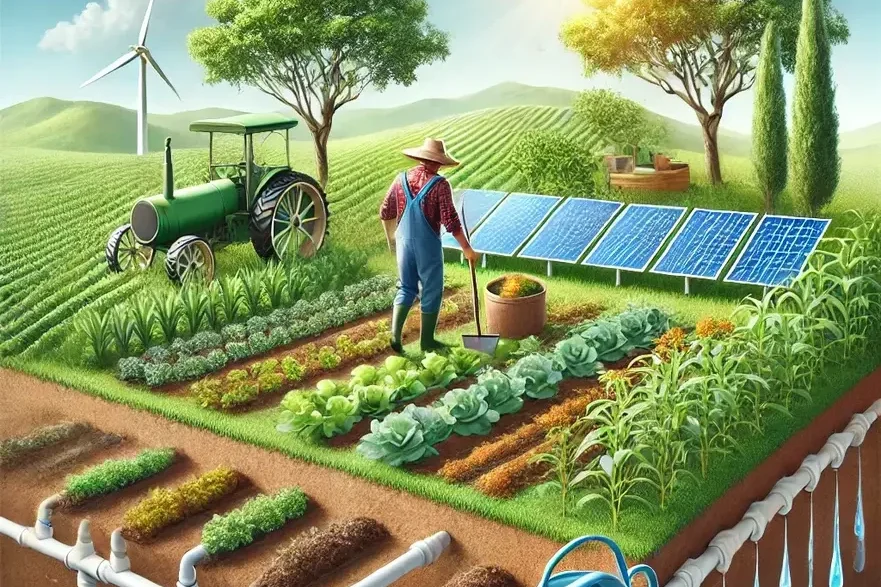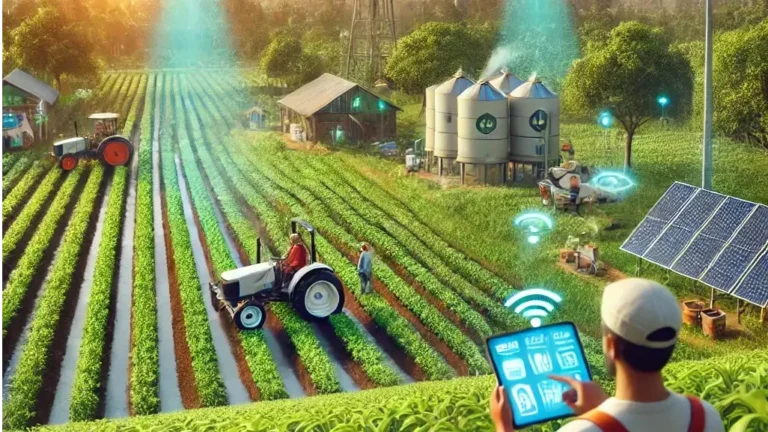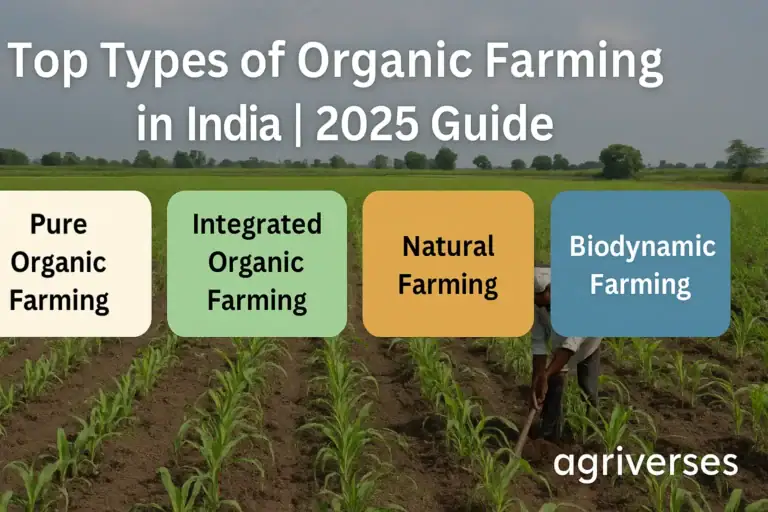1. Introduction

The Agriculture Budget 2025-26 brings big relief for farmers by increasing funding for subsidies, loan waivers, and modern farming techniques. With climate change and rising input costs, the Union Budget for Farmers 2025 focuses on sustainable agriculture, irrigation, and financial support through PM-KISAN Yojana.
The Indian government has increased the total agriculture budget by 11% compared to last year, which will help in strengthening rural infrastructure, modernizing farming techniques, and ensuring better price realization for crops. The Agriculture Budget 2025-26 has allocated ₹1,37,756 crore to the Ministry of Agriculture and Farmers Welfare, accounting for approximately 2.72% of the total government expenditure.
This allocation reflects a 2.9% decrease compared to the previous year’s revised estimate of ₹1.31 lakh crore.
2. Union Budget for Farmers 2025 – Key Highlights
| Category | Budget Allocation (₹ Crore) | Impact on Farmers |
|---|---|---|
| Total Agriculture Budget | 1,37,757 | 11% increase from last year |
| PM-KISAN Direct Benefit Transfer | 72,000 | More financial aid for small farmers |
| Fertilizer & Seed Subsidy | 40,000 | Lower cost of production |
| Irrigation & Water Management | 10,000 | Better irrigation facilities |
| Digital Agriculture & AI | 2,000 | Smart farming & precision agriculture |
| Post-Harvest Infrastructure | 12,000 | Cold storage & better crop prices |
Beyond the Numbers: A Push for Holistic Growth
When we hear about the budget, our minds often get stuck on the big, flashy numbers. And this year, the number is indeed large.
The government has announced a total allocation of approximately ₹1,62,000 crore for agriculture and allied sectors, which includes fisheries, animal husbandry, and food processing. This is an 11% increase from last year.
But what does this 11% jump actually mean on the ground? It’s not just about spending more money; it’s about spending it smarter. For years, we’ve seen budgets that offer temporary relief. This time, the focus seems to be shifting towards building a stronger foundation for the future.
It is a signal that the government is looking beyond just one sowing season and thinking about long-term resilience. The increased funding is aimed at strengthening rural infrastructure—better roads to get produce to the mandi, more reliable electricity for our pump sets, and building storage facilities so we are not forced into distress sales right after harvest. This is a move from mere survival support to enabling prosperity.
3. Major Announcements in Union Agriculture Budget 2025

A. Prime Minister Dhan-Dhaanya Krishi Yojana
Targeting 100 districts with low productivity, benefiting 1.7 crore farmers, Key Objectives:
- Boost crop productivity
- Encourage sustainable farming practices
- Enhance post-harvest infrastructure
- Improve market linkages
B. Mission for Aatmanirbharta in Pulses
Targets: Decrease dependency on pulse imports Invest in climate-resilient, high-yield pulse varieties NAFED and NCCF will purchase pulses from farmers Focus Crops: Tur, Urad, and Masoor
C. National Mission on High-Yielding Seeds
- Develop 100+ high-yield seed varieties
- Focus on climate resilience and pest resistance
- Budget Allocation: ₹ 2,500 crore
D. Five-Year Mission for Cotton Productivity

- Improve cotton yield and quality
- Develop Extra-Long Staple Cotton varieties
- Enhance scientific farming techniques
- ₹3,000 crore was allocated for boosting cotton productivity through better seeds and research
E. Establishment of Makhana Board in Bihar
- Strengthen Makhana (Fox Nut) production & processing
- Support Farmer Producer Organizations (FPOs)
- Promote the export potential of Indian Makhana
- ₹1,200 crore allocated for Makhana (Fox Nut) farmers,
4. Government Schemes for Farmers in Budget 2025
Let’s talk about the money that comes directly into a farmer’s pocket or reduces the burden on it. This is where the budget feels most real.

PM-KISAN Yojana 2025 Fund Allocation
The Pradhan Mantri Kisan Samman Nidhi (PM-KISAN) scheme remains a central pillar. With an allocation of ₹72,000 crore, the government has ensured the Direct Benefit Transfer of ₹6,000 per year will continue.
For a small or marginal farmer, this is not just a small amount. It is the money that buys quality seeds before the Kharif season, the assurance that you can repair a tool without falling into the clutches of a local moneylender.
For over 11 crore farmer families, this scheme is a safety net, a small but significant assurance from the government that it stands with them. You can check your status and find more information directly on the official PM-KISAN portal.
Fertilizer & Seed Subsidy Budget 2025
Equally important is the ₹40,000 crore allocated for fertilizer and seed subsidies. The prices of Urea and DAP have been a major source of stress.
This subsidy aims to act as a shock absorber, keeping these fundamental input costs from spiraling out of control. More importantly, there’s a conscious push towards organic and bio-fertilizers within this allocation.
This is a welcome sign, a recognition that the health of our zameen (soil) is paramount for sustainable farming. Healthy soil means fewer chemical inputs, lower costs, and better produce in the long run.
New Agriculture Loan & Crop Insurance Schemes
- Agricultural credit has been increased to ₹22 lakh crore to provide easier access to loans for farmers. The Pradhan Mantri Fasal Bima Yojana (PMFBY) receives additional funding to protect farmers against crop loss due to natural disasters.
- Interest-free farm loans up to ₹ 3 lakh for small farmers
- ₹ 5,000 crore for crop insurance under PM Fasal Bima Yojana.
- 30% increase in insurance claims for the drought-prone area.
5. Comparison with Previous Agriculture Budgets
| Total Agriculture Allocation (₹ Cr) | PM-KISAN Fund (₹ Cr) | Fertilizer Subsidy (₹ Cr) | Major Reforms |
|---|---|---|---|
| 1,32,513 | 60,000 | 1,05,222 | Digital agriculture push, organic farming incentives (2022-23) |
| 1,41,032 | 65,000 | 1,07,000 | Expansion of irrigation projects, AI in farming (2023-24) |
| 1,50,250 | 70,000 | 1,10,500 | Climate-resilient crops, smart farm mechanization (2024-25) |
1,62,000 | 75,000 | 1,15,000 | Cotton productivity mission, Makhana Board (2025-26) |
Compared to the 2024 budget, the 2025 agriculture budget has seen an 11% increase, with more focus on sustainable farming, digital agriculture, and irrigation projects. The PM-KISAN fund allocation remains the same, but fertilizer and irrigation subsidies have increased. The budget has steadily increased over the years to support farmers with better financial aid and subsidies.
6. How Agriculture Budget 2025 Benefits Farmers

- Lower input costs with fertilizer and seed subsidies
- Easy loan access with zero-interest farm credit
- Better crop insurance to reduce financial risks
- Higher MSP (Minimum Support Price) for key crops
Higher subsidies reduce farming costs
More cold storage & irrigation facilities improve yields
AI-based smart farming increases efficiency
Loan & insurance support ensures financial stability
7. Digital Agriculture & AI in Farming
This budget solidifies the vision for a future where farming is not just about hard labor but also smart decisions. The ₹2,000 crore push for Digital Agriculture & AI is a step in that direction, focusing on three key areas:
- AI-Based Weather Forecasting: Providing farmers with precise and timely advice on their mobile phones, helping them plan everything from sowing to spraying.
- Promoting Drone Technology: Encouraging the use of drones for rapid crop health analysis, monitoring, and efficient application of nutrients and pesticides.
- Expanding the e-NAM Platform: Breaking the monopoly of the local mandi and giving farmers the power to sell their produce to anyone, anywhere in the country, for a better price.
To support all of this, the agricultural credit target has been raised to a massive ₹22 lakh crore, with provisions for interest-free loans up to ₹3 lakh for small farmers.
This increased access to formal credit is crucial to keep farmers out of debt traps and empower them to invest in the technologies that will modernize their practice.
8. Future Growth of the Indian Agriculture Sector
This budget paints a hopeful picture. It dreams of an India that is not just self-sufficient in food grains but is also a leader in agricultural exports.
It envisions a farmer who is not just a producer but an agri-preneur—connected to national markets, empowered by data, and protected by a robust insurance system.
The journey from this vision to reality is long, but the path seems to be paved with the right intentions. The focus on soil health, water conservation, and resilient seeds is a promise to our children that we will leave them a zameen that is fertile and full of life.
The future of farming is not just about subsidies; it’s about sustainability, technology, and dignity.
9. Market Reforms and Export Promotion
The 2025-26 budget includes a ₹7,500 crore allocation for agricultural marketing reforms, focusing on improving agricultural produce market committees (APMCs), e-NAM expansion, and direct farmer-to-consumer sales.
Export Boost for Agricultural Products
The government aims to increase India’s agricultural exports to $100 billion by 2030, providing subsidies for quality improvements, modern processing units, and branding initiatives for key products like spices, tea, rice, and organic foods. Trade agreements and global market access for Indian farmers will be enhanced through bilateral discussions and export incentives.
10. Conclusion
The Agriculture Budget 2025-26 focuses on boosting farmer income, improving productivity, and integrating advanced technology in agriculture. With a significant allocation of ₹1,62,000 crore, the budget supports PM-KISAN, fertilizer subsidies, crop insurance, and smart farming initiatives. Programs like the Cotton Productivity Mission and Makhana Board aim to enhance crop yield and rural livelihoods. The emphasis on AI-driven farming, sustainability, and infrastructure will modernize Indian agriculture, ensuring long-term growth. This budget is a positive step toward a resilient and profitable farming sector, benefiting millions of farmers across the country.
₹1,37,757 crore: This amount is allocated particularly for the Ministry of Agriculture and Farmers’ Welfare for the fiscal year 2025-26. It represents a 2.5% decrease compared to the revised estimate of ₹1,41,352 crore for 2024-25.
₹1,62,000 crore: This amount is the combined allocation for agriculture and allied sectors, including ministries such as Fisheries, Animal Husbandry and Dairying, and Food Processing Industries. When these allied sectors combined the total allocation reaches approximately ₹1,62,000 crore.
Do you think this budget will help farmers? Share your opinion in the comments!
Ready to take your sustainable farming journey to the next level?
If you found this breakdown valuable, please share it with fellow farmers, students in your village, or anyone interested in the future of Indian agriculture. Spreading knowledge is the first step towards empowerment.
This is just the beginning. If you are passionate about eco-friendly agriculture, do not miss our deep dive on Organic Farming Techniques to learn how to boost yields naturally. Curious about turning waste into wealth? Our Biochar Guide breaks down everything you need to know—from making it to applying it in your fields.







2 Comments